AMD Radeon HD 7950 Review Feat. Sapphire & XFX: Sewing Up The High-End Market
by Ryan Smith on January 31, 2012 9:02 AM ESTCrysis: Warhead
Kicking things off as always is Crysis: Warhead. It’s no longer the toughest game in our benchmark suite, but it’s still a technically complex game that has proven to be a very consistent benchmark. Thus even 4 years since the release of the original Crysis, “but can it run Crysis?” is still an important question, and the answer continues to be “no.” While we’re closer than ever, full Enthusiast settings at a 60fps is still beyond the grasp of a single-GPU card.
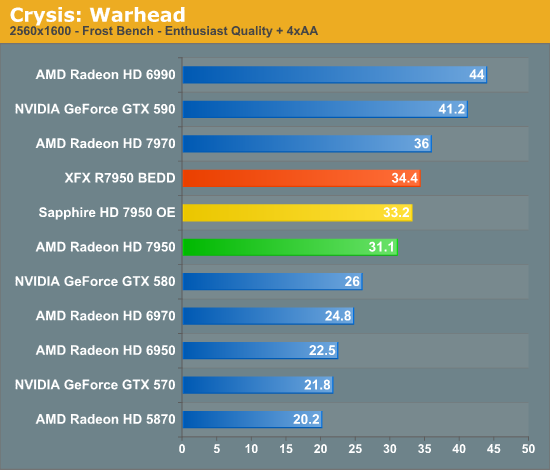
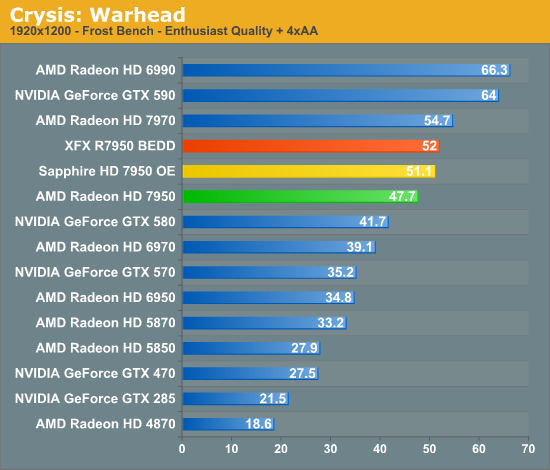
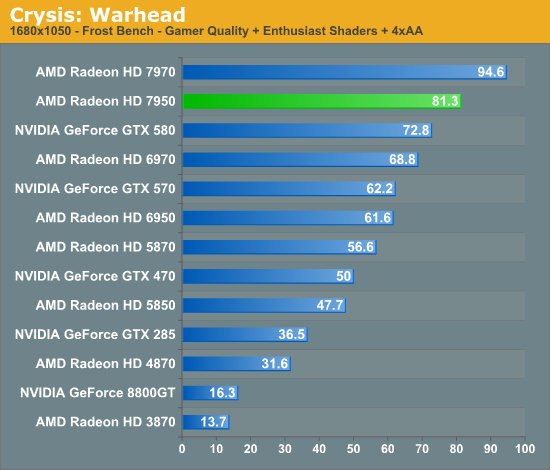
AMD’s first round of driver optimizations have given the 7900 a very solid footing in Crysis, putting the 7950 off to a great start. The 7950 is 19% ahead of the GTX 580 at 2560 and 14% ahead at 1920, putting the card in a comfortable position that for single-GPU cards is second only to the 7970. In spite of Crysis being shader-bound most of the time the 7950 is generally within 15% of the 7970, so it’s doing better than the theoretical performance gap between the two cards would predict. Meanwhile compared to AMD’s last generation offerings it’s not much of a contest: the 7950 is 20-25% ahead.
As for our factory overclocked Sapphire and XFX cards, they further close the gap between the 7950 and 7970. The 12.5% core overclock on these cards puts them between 7% and 10% faster than the stock clocked 7950, with the XFX card edging out the Sapphire due to its memory overclock. These cards do so well here than the reference 7970’s lead is reduced to just 5%.
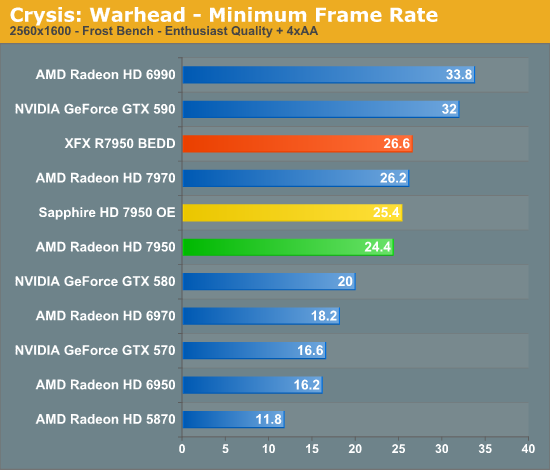

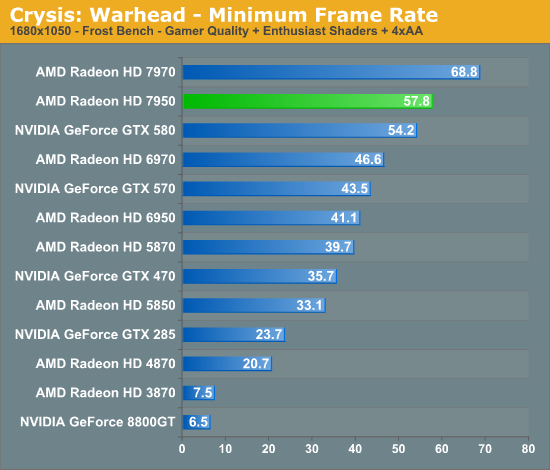
The minimum framerates in Crysis are also looking good on the 7950, with the 7950 turning in a 10-22% better minimum framerate than the GTX 580 depending on whether we’re talking about 1920 or 2560. As like we saw with the 7970, the biggest lead is at the highest resolutions, which has typically been the case for AMD cards for some time now. The overclocked partner cards add to this, tacking on an extra 5-10% in performance.










259 Comments
View All Comments
chizow - Wednesday, February 1, 2012 - link
Sorry, but this is incorrect. Nvidia and AMD are direct competitors when it comes to GPUs so relative performance directly influences price.This is why AMD cannot sell CPUs for more than $200. They don't have anything faster than Intel's 10th+ fastest processors (spread over 2-3 generations, its pretty sad actually), so they can't just price Bulldozer at $1000 by slapping an X on it and expect to sell any.
There is a ceiling on the prices they can charge however due to economic and external factors like price elasticity of demand, disposable income, GDP, competing products (consoles etc) so within that construct, AMD and Nvidia have to price their products to make them most attractive to prospective buyers.
They know exactly what % of the market will bite at each price and performance tier using their own gathered market research as well as independent firms like Peddie etc. $400+ is high-end enthusiast, in order to price here, you have to be the top dog, or the 2nd tier. The top dog sets the table for every other GPU, it doesn't matter who makes it.
Historically, this next-gen top dog has shifted the price and performance metric for all next-gen GPUs because the market expects and demands it. That's just progress. Tahiti brings nothing to the table in this regard, its performance is incremental but its pricing just maintains the status quo.
The problem is Tahiti's pricing indicates the GTX 580 was the target it was shooting for, the problem is, they should've been taking aim at Kepler.
JNo - Thursday, February 2, 2012 - link
chizow - the new pirks?TerdFerguson - Tuesday, January 31, 2012 - link
Chizow is right, you guys are wrong. Get over it.Consumer electronics are supposed to get cheaper AND faster at tremendous rates. In failing to improve their price/performance ratio over a couple of generations, AMD has failed. NVidia is failing pretty badly right now, too, but since this is an AMD release, AMD is getting the flack at the moment. If you apply AMD's pricing model to any other consumer electronics product, it becomes very evident that things are very broken. Would you pay $4k for a Ivy Bridge CPU, because IB > SB > Core2 > Core > P4 > P3 > P2 > Pentium > 486 > etc, and a better chip must always command a price premium? Doh, of course you wouldn't.
mdlam - Tuesday, January 31, 2012 - link
Pricing is determined and adjusted based on the law of efficient markets. the 580 is 500 dollars only because people are still willing to pay for it, not because of Chizow's ridiculous theory that companies conspire these fabulous schemes to trick people out of their money. So based on this existing market of people willing to pay 500 dollars for gtx580 performance benefits, AMD is going to TAKE those customers away by giving more for less, or more for more in a linear price/performance scale. It's just how markets work, prices don't revolve around these God-like rules of tier1, tier2, tier3. Guess what, AMD is right, because these cards right now are selling higher than the $550 retail price. They should have priced it at $650!mdlam - Tuesday, January 31, 2012 - link
And there is no flawed pricing model to AMD that would end up with a slippery slope of $4k for an Ivy bridge. Prices = aggregate buying desire of the market. All markets usually hit a ceiling price for an item, no matter what it is. Some people have a high ceiling, some people have a low ceiling, its not anyone's fault, its just the fact of life. Any company, AMD or NVIDIA, or INTEL, will price to sell to people with higher ceilings, and when demand is met, lower price to increase adoption from folks with lower ceilings.chizow - Wednesday, February 1, 2012 - link
Sorry, not in this market.If you think this is OK, there would never be any progress in the semiconductor market. Its not like we're talking cars here where a new model year means a few minor upgrades.
With GPUs, CPUs and any other semiconductor, you expect FASTER performance at the SAME prices or CHEAPER prices. That's called progress.
The law of efficient markets would tell you if you bought a GTX 580 14 months ago, you made the right call. Buying today, you're setting yourself up for some heartache, but more probably, you're kicking yourself for waiting.
Arnir69 - Friday, February 3, 2012 - link
I'm really disappointed with 7950 too, it's a little bit better than 580 but not enough to justify a such a long wait, it's performance is well short of expectation in BF3.hyperdoggy - Tuesday, January 31, 2012 - link
While I'm not in favor of the prices AMD has set for the new cards, you do realize that Nvidia has never prices their cards low right? A quick price check history will show you since the FX day Nvidia has priced their card to sell your kidney. It was the tnt days that Nvidia did a price favor vs their competitors. I bet you my right kidney(i sold my left one for a 8800gtx for $650 day 1 of lunch) that Kepler will be no different, regardless of what its performance will be.I never got the fanboy aspect of things, you see gamers that can calculate min-max fps better than most math majors yet somehow only see red or green when the numbers are laid out right in front of them. I'm shame to say i'm old enough to been around from the voodoo days, i went to Voodoo, Nvidia, Ati, Nvidia, Ati, Nvidia, and now name AMD for more than i can remember. Go for what's best at the time you need an upgrade. Stop making yourself colored hulk when your team doesn't have a product to be competitive.
SlyNine - Tuesday, January 31, 2012 - link
Yea and the 8800GTX kicked stomped the crap out of the competition. This is just a bump up, and kick stomp prices.Plus this is AMD not Nvidia. Where is the 5870, the 9700pro. This is closer to a 5800Ultra or a 2900XT. Of course those cards at least had some real competition in the form of a 8800GTX and 9700pro.
If the 8800GTX and 9700pro would have only increased performance as much as say the 6970 or 580GTX ( compared to their previous cards 5870/480) then the analogy would truly work and the 7970 would basicly be the 2900XT/5800Ultra of its day.
chizow - Tuesday, January 31, 2012 - link
Actually if you look at recent pricing history, you'd see Nvidia has kept their flagship pricing in-line and much lower than what we are seeing here with SI, despite the fact Nvidia had the leading part for that generation in both cases with the GTX 480 and GTX 580.Both of those parts launched at $500 and were faster than AMD's competing same-generation part. If Nvidia did the same as AMD, the 580 would've been priced at $550-600 for that 10-15% performance bump over the 480, but they kept their pricing constant while increasing performance. As I stated earlier, AMD definitely had a hand in this when they undercut the GTX 280 so badly in 2008, but Nvidia did learn their mistake and has not raised the pricing metric since.
Now Nvidia does have a decision to make. If they beat SI with Kepler as expected, they can go with AMD's pricing which will again, make no sense. Or they can stick to their historical price/performance model and make AMD look really bad just as AMD did to them 3 1/2 years ago.